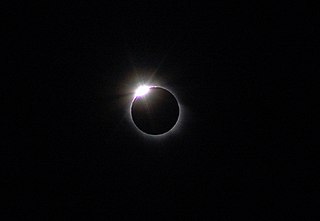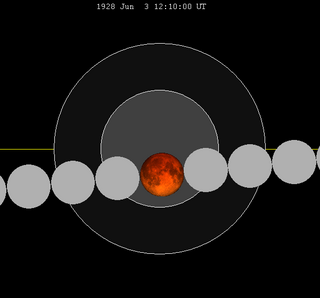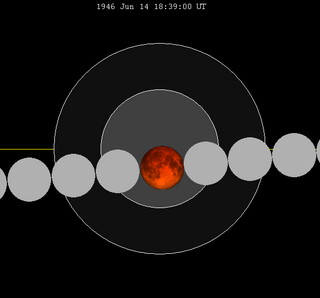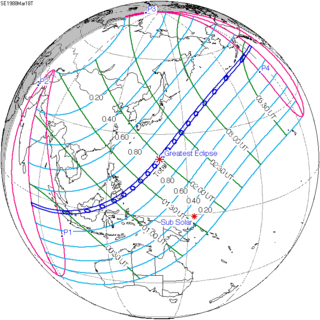
A total solar eclipse occurred on March 29, 2006. A solar eclipse occurs when the Moon passes between Earth and the Sun, thereby totally or partly obscuring the image of the Sun for a viewer on Earth. A total solar eclipse occurs when the Moon's apparent diameter is larger than the Sun's, blocking all direct sunlight, turning day into darkness. Totality occurs in a narrow path across Earth's surface, with the partial solar eclipse visible over a surrounding region thousands of kilometres wide. It was visible from a narrow corridor which traversed half the Earth. The magnitude, that is, the ratio between the apparent sizes of the Moon and that of the Sun, was 1.052, and it was part of Saros 139.

A total lunar eclipse will take place on August 7, 2036. The southern tip of the Moon will pass through the center of the Earth's shadow. This is the last central lunar eclipse of Saros cycle 129.

A total lunar eclipse will take place between Monday and Tuesday, June 25-26, 2029. A central total eclipse lasting 1 hour and 41 minutes 53 seconds will plunge the full Moon into deep darkness, as it passes right through the centre of the Earth's umbral shadow. While the visual effect of a total eclipse is variable, the Moon may be stained a deep orange or red color at maximum eclipse. It will be able to be seen from most of the Americas, Western Europe and Africa. The partial eclipse will last for 3 hours and 39 minutes 32 seconds in total.

A total lunar eclipse occurred at the Moon's descending node on 27 July 2018. The Moon passed through the center of Earth's shadow in what was the first central lunar eclipse since 15 June 2011. It was also the second total lunar eclipse in 2018, after the one on 31 January. It was the longest total lunar eclipse of the 21st century, but not the longest in the 3rd millennium. The longest total lunar eclipse of the 3rd millennium will occur on May 12, 2264, lasting 106 minutes and 13.2 seconds, which will be the longest total lunar eclipse since 2000, and the longest one until 3107.
A total lunar eclipse took place on Tuesday, July 6, 1982, the second of three total lunar eclipses in 1982, and the only one that was in the descending node. A dramatic total eclipse lasting 1 hour and 46 minutes plunged the full Moon into deep darkness, as it passed right through the centre of the Earth's umbral shadow. While the visual effect of a total eclipse is variable, the Moon may have been stained a deep orange or red colour at maximum eclipse. This was a great spectacle for everyone who saw it. The partial eclipse lasted for 3 hours and 56 minutes in total.

A total lunar eclipse took place on Thursday, June 25, 1964. The Moon passed through the center of the Earth's shadow.

A total lunar eclipse took place on Sunday, July 26, 1953.
A total lunar eclipse took place at the Moon's descending node of the orbit on Tuesday, May 24, 1910 with an umbral eclipse magnitude of 1.09503. A total lunar eclipse takes place when the Earth comes between the Sun and the Moon and its shadow covers the Moon. Eclipse watchers can see the Moon turn red when the eclipse reaches totality. Total eclipses of the Moon happen at Full Moon when the Sun, Earth, and Moon are aligned to form a line. The astronomical term for this type of alignment is syzygy, which comes from the Greek word for being paired together. The Moon does not have its own light but shines because its surface reflects the Sun's rays. During a total lunar eclipse, the Earth comes between the Sun and the Moon and blocks any direct sunlight from reaching the Moon. The Sun casts the Earth's shadow on the Moon's surface. A shallow total eclipse saw the Moon in relative darkness for 49 minutes and 29.5 seconds. The Moon was 9.503% of its diameter into the Earth's umbral shadow, and should have been significantly darkened. The partial eclipse lasted for 3 hours, 35 minutes and 22.9 seconds in total.

A total lunar eclipse took place on Sunday, June 3, 1928.

A total lunar eclipse took place on Friday, June 14, 1946. The northern tip of the moon passed through the center of the Earth's shadow. This was the first central lunar eclipse of Saros series 129.

A total lunar eclipse will take place on August 18, 2054.

A total lunar eclipse will take place on August 28, 2072.

A total lunar eclipse will take place on September 8, 2090.

A total solar eclipse will occur at the Moon's descending node of the orbit on Saturday, March 30, 2052. A solar eclipse occurs when the Moon passes between Earth and the Sun, thereby totally or partly obscuring the image of the Sun for a viewer on Earth. A total solar eclipse occurs when the Moon's apparent diameter is larger than the Sun's, blocking all direct sunlight, turning day into darkness. Totality occurs in a narrow path across Earth's surface, with the partial solar eclipse visible over a surrounding region thousands of kilometres wide. The path of totality will cross central Mexico and the southeastern states of the United States. Almost all of North America and the northern edge of South America will see a partial eclipse. It will be the 2nd total eclipse visible from the Florida Panhandle and southwest Georgia in 6.6 years. It will be the first total solar eclipse visible from Solar Saros 130 in 223 synodic months. It will be the last total solar eclipse visible in the United States until May 11, 2078.

A total solar eclipse will occur on Sunday, April 20, 2042. A solar eclipse occurs when the Moon passes between Earth and the Sun, thereby totally or partly obscuring the image of the Sun for a viewer on Earth. A total solar eclipse occurs when the Moon's apparent diameter is larger than the Sun's, blocking all direct sunlight, turning day into darkness. Totality occurs in a narrow path across Earth's surface, with the partial solar eclipse visible over a surrounding region thousands of kilometres wide. It will be seen significantly in Western Indonesia, Eastern Malaysia, Brunei and the Philippines.

A total solar eclipse will occur on Wednesday, May 11, 2078. A solar eclipse occurs when the Moon passes between Earth and the Sun, thereby totally or partly obscuring the image of the Sun for a viewer on Earth. A total solar eclipse occurs when the Moon's apparent diameter is larger than the Sun's, blocking all direct sunlight, turning day into darkness. Totality occurs in a narrow path across Earth's surface, with the partial solar eclipse visible over a surrounding region thousands of kilometres wide.

A total solar eclipse occurred on March 18, 1988. A solar eclipse occurs when the Moon passes between Earth and the Sun, thereby totally or partly obscuring the image of the Sun for a viewer on Earth. A total solar eclipse occurs when the Moon's apparent diameter is larger than the Sun's, blocking all direct sunlight, turning day into darkness. Totality occurs in a narrow path across Earth's surface, with the partial solar eclipse visible over a surrounding region thousands of kilometres wide. Totality was visible in Indonesia and southern Philippines.

A total solar eclipse will occur on July 13, 2037. A solar eclipse occurs when the Moon passes between Earth and the Sun, thereby totally or partly obscuring the image of the Sun for a viewer on Earth. A total solar eclipse occurs when the Moon's apparent diameter is larger than the Sun's, blocking all direct sunlight, turning day into darkness. Totality occurs in a narrow path across Earth's surface, with the partial solar eclipse visible over a surrounding region thousands of kilometres wide. Totality will pass through the centre of Brisbane and the Gold Coast, as well as Geraldton, Western Australia

Saros cycle series 129 for lunar eclipses occurs at the moon's descending node, repeats every 18 years 11+1/3 days. The 129th lunar saros is associated with Solar Saros 136.

A total lunar eclipse will occur on Wednesday, June 9, 2123, with maximum eclipse at 05:06 UTC. A dramatic total eclipse lasting 106 minutes and 6 seconds will plunge the full Moon into deep darkness, as it passes right through the centre of the Earth's umbral shadow. While the visual effect of a total eclipse is variable, the Moon may be stained a deep orange or red colour at maximum eclipse. This will be a great spectacle for everyone who sees it. The partial eclipse will last for 3 hours and 56 minutes in total. The penumbral eclipse lasts for 6 hours and 14 minutes. Maximum eclipse is at 05:06:28 UT. This will be the longest Total Lunar Eclipse since 16 July 2000, and the longest one until 12 May 2264 and 27 July 3107, though the eclipse on June 19, 2141 will be nearly identical in all aspects. This will also be the longest of the 22nd century and the second longest of the 3rd millennium. The eclipse on June 19, 2141 will be the second longest of the 22nd century and the third longest of the third millennium.













































































































